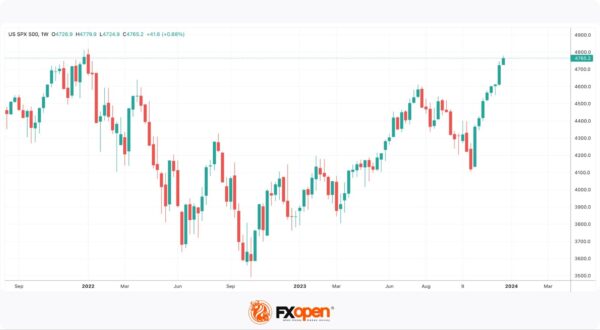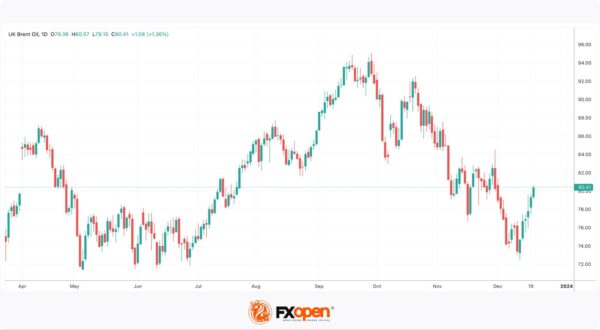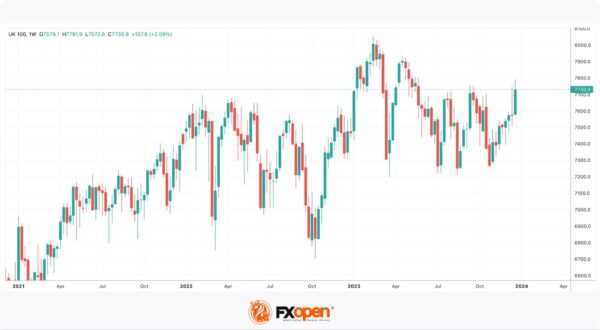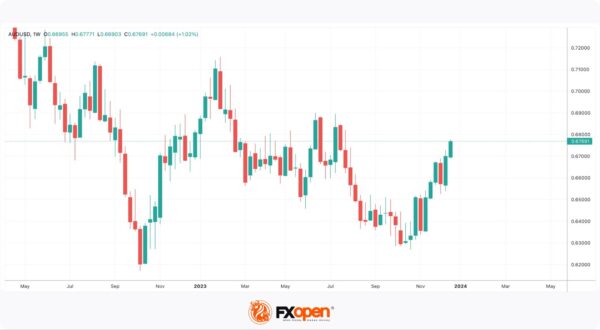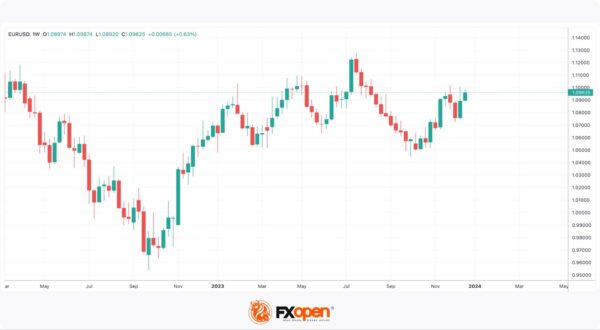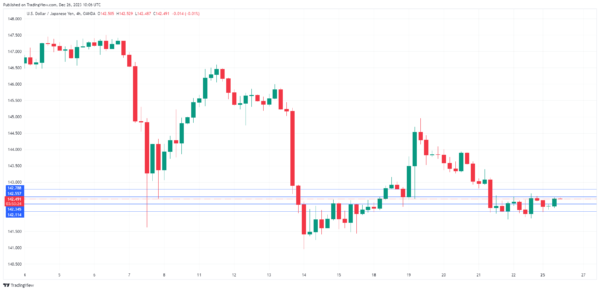The year 2023 commenced after two years of economic uncertainty and heavy inflation across Europe and North America, home to leading financial markets, with major currencies such as the euro and the US dollar, and financial hubs including London, New York, Chicago, Frankfurt, and Toronto.
These continents, where major stock exchanges operate and the S&P 500, NASDAQ, and FTSE 100 indices represent the top stocks of the top listed companies in Britain and the US, witnessed a dynamic interplay of economic recovery, inflation challenges, and policy adjustments.
The European and North American economies had spent 2023 recovering from a sustained period of inflation and cost of living issues (Britain and mainland Europe), and in the US, yet more bank collapses and a close call with state insolvency as the US Government had to raise the debt ceiling to stop it defaulting on its existing commitments, highlighting the country’s huge national debt.
Inflation did decline during 2023, but central bank policy on both sides of the Atlantic favoured continued increases in interest rates, despite the US inflation going down from 11% in mid-2022 to around 3.1% now, and the British inflation rate is 3.9% now whereas it was also in double figures during 2022. Now, we move on to looking at specific markets.
Indices – S&P Is The Stellar Performer
With regard to indices, the outright performer during the course of this year has been the S&P 500, which has managed to achieve a return of approximately 24% year-to-date, which is a remarkable increase over its usual average of approximately 10%.
As far as global indices are concerned, this stellar performance from the companies whose listed stocks are included in the S&P 500 index puts it in second place globally, with only the Nasdaq 100 Index having outshone it. However, it is worth noting that Japan’s Nikkei 225, whilst not considered one of the top performers by many analytical publications, has done well with a gain of 26.35% year-to-date. Thus, depending on the rankings referred to, the S&P 500 ranks between second and third place in terms of annual performance – but the point is that it has more than doubled its annual average in 2023.
What is fascinating about this is that just seven companies, those being Apple, Google’s parent Alphabet, Meta Platforms (formerly Facebook), Microsoft, NVIDIA, Amazon.com, and Tesla, had driven the S&P 500 index to its stratospheric growth during the first six months of 2023.
What a contrast to the previous year’s tech stock doldrums!
The High Volatility of the Oil Market
In commodities markets, international relations, politics, and, in the case of the past two years, wars in regions with oil-producing significance are historically major factors causing market volatility.
Just almost two years on from the beginning of the war between Ukraine and NATO allies and Russia, which is an OPEC+ country and one of the world’s largest suppliers of energy products, there is now another war, this time in the Middle East which involves Israel backed by Western NATO allies, with oil-producing nations such as Iran being in the background.
With such instability in the geopolitical sphere, oil prices have been volatile this year. There was notable volatility all year in oil markets; however, by mid-October 2023, the war in the Middle East had caused oil prices to climb to $94 a barrel.
It also reignited fears among oil traders and economists that markets could breach the $100 a barrel mark.
This did not happen, and prices slowed again. By the beginning of December, the focus was on whether oil-producing countries would scale back production a bit more in order to bolster demand.
These volatile peaks this year have been sudden and shorter-lived than in 2022 when they were noticeably longer. In mid-2022, it was entirely possible to pull into a fuel station in France and pay 2.20 euros for a litre of unleaded fuel!
Tech Stocks – The Enthusiasm Is Back
2023 heralded a return to the forefront of tech stocks. This was reflected heavily in the strident performance of the S&P 500 index in the United States; however, when looking at the entirety of US-listed technology stocks, which are largely listed on New York’s Nasdaq exchange, it would be fair to call 2023 the year of an absolute resurgence. Nasdaq Composite gained over 40% in value year-to-date.
This performance has overshadowed the period of time during 2021 and 2022 when somewhat risky entries into the Nasdaq listings by SPAC companies were de rigueur, and the ensuing year of 2022 was a year of total decline in tech stocks.
This has reversed, and Nasdaq’s performance in 2023 demonstrates a return to favour of tech stocks, and not one mention of the four-letter acronym SPAC has been uttered for almost two years now. Stability, it seems, is back on track.
The bricks-and-mortar FTSE100 index in the United Kingdom has once again demonstrated that institutional stability gained by the tracking of age-old blue-chip corporations listed on the London Stock Exchange is a bastion of buoyancy. There are a series of financial services giants included in the FTSE 100, along with engineering stalwarts, housebuilders, entertainment and retail conglomerates and scientific corporations.
Perhaps rather surprisingly, Hargreaves Lansdown, Britain’s largest retail financial services company, was deleted from the FTSE 100 index in the last quarter of 2023. However, the index itself has performed with average results this year.
The euphoric surge of 2021, when it reached 7,000 points for the first time, was not replicated in 2023, and despite some degree of celebration when it approached 8,000 during the earlier part of 2023, this was short-lived and never replicated.
Stability and steadiness are the order of the day when it comes to Britain’s stock markets. It is a different animal to the US tech sector, and far more grey suit, and less Silicon Valley.
Australian Dollar: Association With Commodities?
Now we move to currencies, and whilst on the subject of commodities, we can start with the Australian dollar.
During the first month of 2023, there was a steady rise in AUD/USD and many traders considered at the time that AUD/USD was going to be considered one of the most preferred currency pairs for traders in the commodities market, which makes sense given Australia’s highly important mining and mineral extraction industry which trades its raw materials on Australia’s commodities markets.
Toward the end of this year, the AUDUSD was moderately volatile. The AUDUSD pair moved from its high point in early 2023 of 0.71 on the 26th of January through a series of moderate spikes but an overall downward move during the second half of the year, resting at 0.63 on the 3rd of October.
The Cable – Volatility Is Back
The GBPUSD pair, often referred to as ‘The Cable,’ has been very volatile this year, which is interesting given that both the US and Britain have been faced with similar economic matters such as fighting inflation, post-lockdown debts, and energy price increases far beyond the percentage of retail price inflation. Just in the past month alone, the GBPUSD went from 1.25 to 1.27. These currencies are often not volatile at all. Thus, a movement of a few cents in either direction is a matter to consider when measuring the market sentiment.
EURUSD: Similar Policies, Different Movements
The EURUSD pair has experienced higher and lower moments during the course of this year, and despite the European Union member states having experienced similar challenges and been subject to similar geopolitical matters as the United States and Britain, there has been some movement between the euro and the US dollar.
By mid-July, during the height of summer, the EURUSD pair was up to 1.12, which is a considerable uptick from the low point of 1.05 at which it began the year. Interestingly, the European Central Bank had held off from making interest rate increases during 2022, something that was being watched very closely, whilst the US and British monetary policy was staunchly in favour of continued increases.
Of course, the ECB ultimately gave way and did increase rates, but far less frequently than its Anglosphere counterparts, whose major currencies are traded against the euro.
Overall, the European economy has done quite well during 2023, and the energy-related matter of natural gas supplies being in jeopardy due to political sanctions appears to have largely resolved itself. As the final two weeks of 2023 are in swing, the EURUSD stands at 1.09, which is not as high as the summer but a little higher than its low entry in January this year.
Bank Demises – Business As Usual
In the US, there have been a few economic issues that have dented investors’ and economic analysts’ confidence. The aforementioned bank-related toxicity in which some large, well-established banks became insolvent was a major event of 2023.
Silicon Valley Bank collapsed after 50 years in business, and the surrounding contagion saw the end of some smaller regional banks like First Republic Bank, which got mopped up by JPMorgan after its demise.
Credit Suisse, one of the world’s largest Tier 1 investment banks, with a substantial market share in interbank FX currency dealing, finally went bankrupt, and whilst that is a Swiss bank, the effect of its demise was mostly felt on Wall Street. Oddly, the US dollar has not been too adversely affected by these catastrophes, despite them following a similar set of circumstances to the ones that caused the global financial crisis in 2008/2009.
This time, the news passed, and the US dollar has remained very strong. There has been absolutely no talk of the world’s reserve currency being usurped by another major, even during the period earlier this year when the country had to increase its debt ceiling to be able to continue to service its national debt, which is higher than the United Kingdom’s national debt in terms of percentage debt to GDP ratio, and with the UK having had no such issue in servicing its commitments.
Overall, the US dollar has held up very well indeed over not just 2023 but also previous years, despite lockdowns, involvement in wars, and spiralling national debt. It is clear that the hard-working nature of the American public has kept productivity high.
Monetary Policy: Interest Rate Hikes Blighted 2023
Almost absolutely unified in terms of monetary policy, the Bank of England and the US Federal Reserve have been continuing to increase interest rates even during a period in which inflation is decreasing. There has been some talk of stopping the interest rate increases, but this has not yet materialised. The cost of maintaining existing commitments for large corporations has increased due to having to service loans at higher rates, but as is clear from the stock market performance of larger, well-capitalised corporations, this has not hampered their performance at all.
Britain has lived through Brexit-related wranglings and the shortest prime ministerial term in history, whereas the US lived through almost going bankrupt. Despite the media sensationalism, however, both countries are in overall good shape as far as everyday life is concerned for most people.
Volatility in the currency markets appears to be originating from news-driven trading, which is perhaps why it is so sudden and changeable.
It’s been a fascinating year. A year of rebuilding the economy from bizarre policy and a year of battling global headwinds. What will 2024 bring?
This article represents the opinion of the Companies operating under the FXOpen brand only. It is not to be construed as an offer, solicitation, or recommendation with respect to products and services provided by the Companies operating under the FXOpen brand, nor is it to be considered financial advice.




